Behind the Scenes at Medieval Times, Where Knights Battle and Pepsi Is Plentiful
We sent two staffers to spend the day at the dinner theater’s New Jersey outpost.
At Atlas Obscura, we write about places, people, and phenomena that engender wonder and delight. Usually that’s stuff like bone churches, hidden beaches, and abandoned amusement parks. But what qualifies as “wondrous” depends on so many things. For some, New Jersey can be a wonder, especially if you happen to have grown up outside of the United States.
Another wonder might be a form of dinner theater—the ultimate dinner theater of the ’90s—that never actually went away.
The Medieval Times chain of castles offers a “dinner and tournament” experience intended to evoke the Middle Ages. Guests eat a four-course feast with their hands while watching six knights fight one another in front of the host king. Founded in Majorca, Spain, Medieval Times opened its first U.S. venture in Florida in 1983. There are now nine castles in North America.

On the afternoon of April 14, 2016, two Atlas Obscura reporters, Ella Morton and Urvija Banerji, made a pilgrimage from New York to the Medieval Times in New Jersey. This is our story.
The Pre-Trip Expectations
Ella: Like many others whose adolescence coincided with the mid-’90s, my introduction to Medieval Times came by way of The Cable Guy. I watched Janeane Garofalo as a fed-up serving wench and Jim Carrey putting chicken skin on his face in a Silence of the Lambs homage and thought, “America: what a place.”
Ella: Indeed, Medieval Times seemed to epitomize the United States’ most enticing offerings, what with its gift shop full of tchotchkes, overabundant food, carefully choreographed spectacles, and unlimited Pepsi refills. [Ed.: Ella grew up in Australia.]
Urvija: I have never watched The Cable Guy, so I had no idea what everyone was talking about. When Medieval Times first came up in a conversation a couple of years ago (because of course it did), I immediately put it on my U.S.A. bucket list. What could be more American than fake British accents and pseudo old-world kitsch? [Ed.: Urvija grew up in Singapore.]
I read this Yelp review of Medieval Times in preparation, which was written by this very nice frat bro who went to the NJ castle with all his frat bro pals. In the review, the frat bro enthused that his experience was as Game of Thrones as one can get outside of Westeros, and mentioned that he particularly enjoyed eating with his hands and drinking beer out of huge tankards. Given that the new season of GoT is close upon us, this review was more than enough for me to attempt to bring out my inner Khaleesi while there.
Ella: The whole “Millennials going to Medieval Times ironically” thing seems to be something people do, but there was nothing ironic about my visit. I was genuinely excited. It felt like we were going on a real quest. Or even a crusade.

Journeying to the Castle
Ella: It has oft been noted that New York’s Port Authority Bus Terminal is a less-than-enchanting place. The commuter hub links midtown Manhattan with New Jersey, meaning our trip to the castle began amid a bunch of nine-to-fivers just looking to get home. After queueing alongside them in the terminal, we boarded our chariot. By which I mean the 199 bus to Lyndhurst.
Urvija: I think there’s something pretty magical in emerging, bleary-eyed, from within the belly of the Lincoln Tunnel into New Jersey. The view of Manhattan is fantastic.

The Arrival
Ella: The Medieval Times castle is located just down the road from a Courtyard Marriott and a Quality Inn. Our journey from the Port Authority took approximately 18 minutes. I was giddy the whole time. And then I saw it in the distance: the castle turret.
Urvija: As we walked from the bus stop toward the castle, our excitement only grew; so much so that once we reached the Medieval Times parking lot (a solid moat replacement, albeit a bit gravelly), we had to pause to catch our breath. And take photographs. Many enraptured, overeager photographs.

Urvija: Since we were arriving a few hours before the show began, we had been instructed to forgo the main entrance for a side door. At first this seemed a little disappointing, but soon became an adventure in its own right. Under strict instructions, we followed a side path along the castle, as though we were stealthy pillagers or castle robbers or something.
As we reached the side door, we had been told to look out for a mighty Medieval Times carriage. It ended up being a truck, with the Medieval Times logo painted on it, and “1-800-WE-JOUST” emblazoned beneath.

Ella: When we stepped inside, the first thing I noticed was the smell of horses. You know. Manure. But in a “we’re on a farm” way. It wasn’t an offensive odor. There was a pastoral warmth to it.
Behind the Scenes
Ella: Our backstage tour began with a visit to the stables, where we met an elegant Andalusian horse.
Urvija: An equally elegant lady rider stood by his side: Assistant Horse Trainer Amanda Kenny. The stables were surprisingly quiet for a few hours before the evening show, and the trainer and her horse cut a strong figure against the calm surroundings.
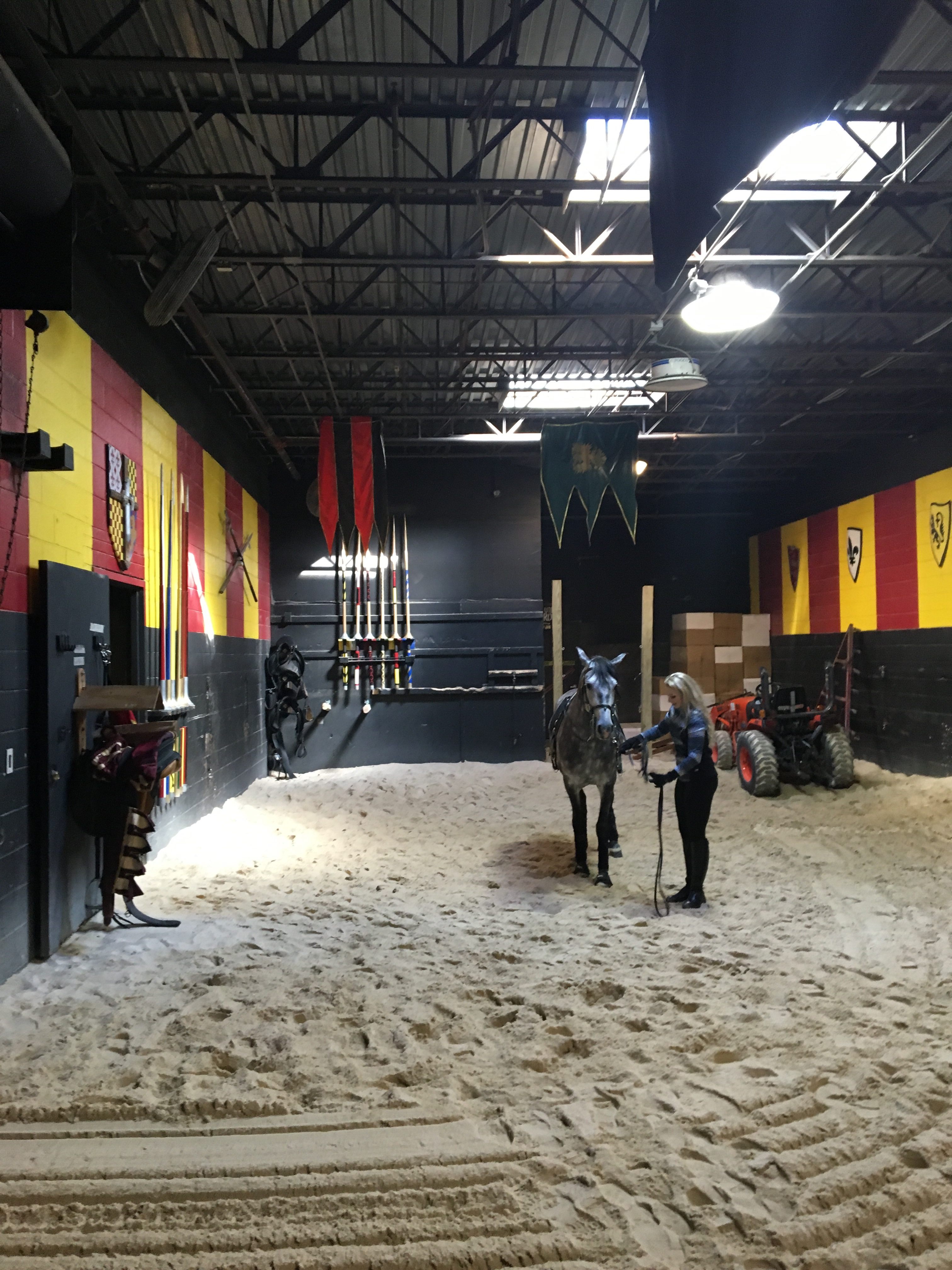
Urvija: Amanda explained that the horses at Medieval Times are bred at Chapel Creek Ranch in Sanger, Texas, which is essentially a ranch dedicated to breeding horses for Medieval Times. The stallions work at a given castle from the ages of three to 15-19, after which point they retire back at the same ranch. The horses work the nightly shows on rotation, and each is given between two and three days off a week.Training is needed for humans, too. Most beginner knights arrive at Medieval Times without any experience on horseback whatsoever, and it is her job to get them into shape to perform the complex stunts and maneuvers we see during the show.
On our way out of the stables, we passed by the costume room, a wonder in itself, and the knight’s locker rooms, which we were obviously, but nevertheless unfortunately, not allowed to enter.

Ella: We next ventured into the castle arena. This was big. (Both literally—it has over 1,400 seats—and in terms of emotional impact.) A great swathe of sand lay before us, surrounded by color-coded seating sections.
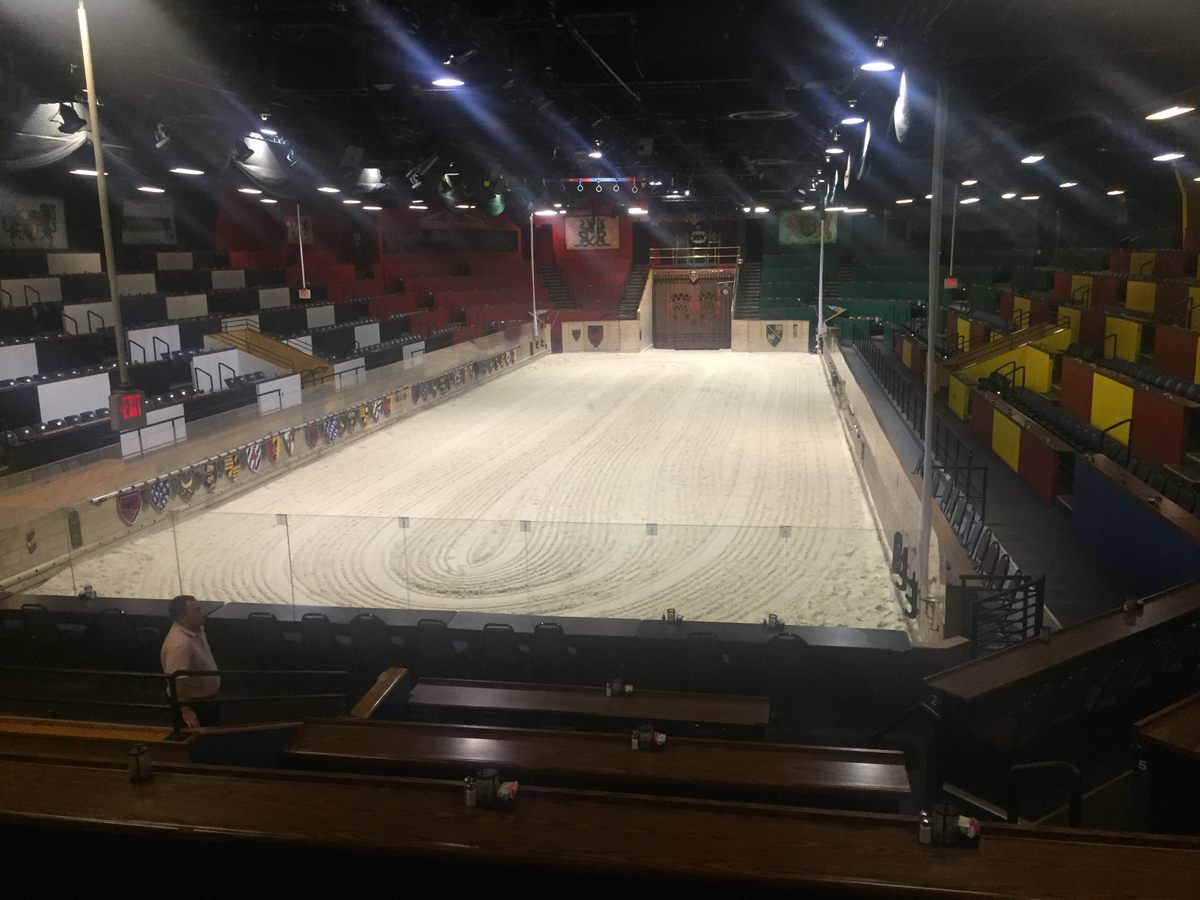
Ella: Each section was devoted to a particular knight, for whom we would all later cheer. You can’t choose your knight. Your knight is given to you, like a gift. We ended up being aligned with the blue knight. Just like Jim Carrey in The Cable Guy.

Ella: Before the show each evening, the knights come out into the sand and fight each other—ostensibly for rehearsal and safety reasons, but it seemed like they were also doing it for funsies. Each knight wore a “Get Medieval” shirt with their last name printed on the back. This was the first of many moments in which we felt like we were at a sporting match.
Urvija: Neither Ella nor I could resist the temptation of holding one of their 20-pound weapons for ourselves. Can confirm, they are heavy, and unsurprisingly, very empowering to hold. The blades themselves are dulled down, but all of Medieval Times’ weaponry is made from the same titanium steel that would go into making a functional weapon of its kind.
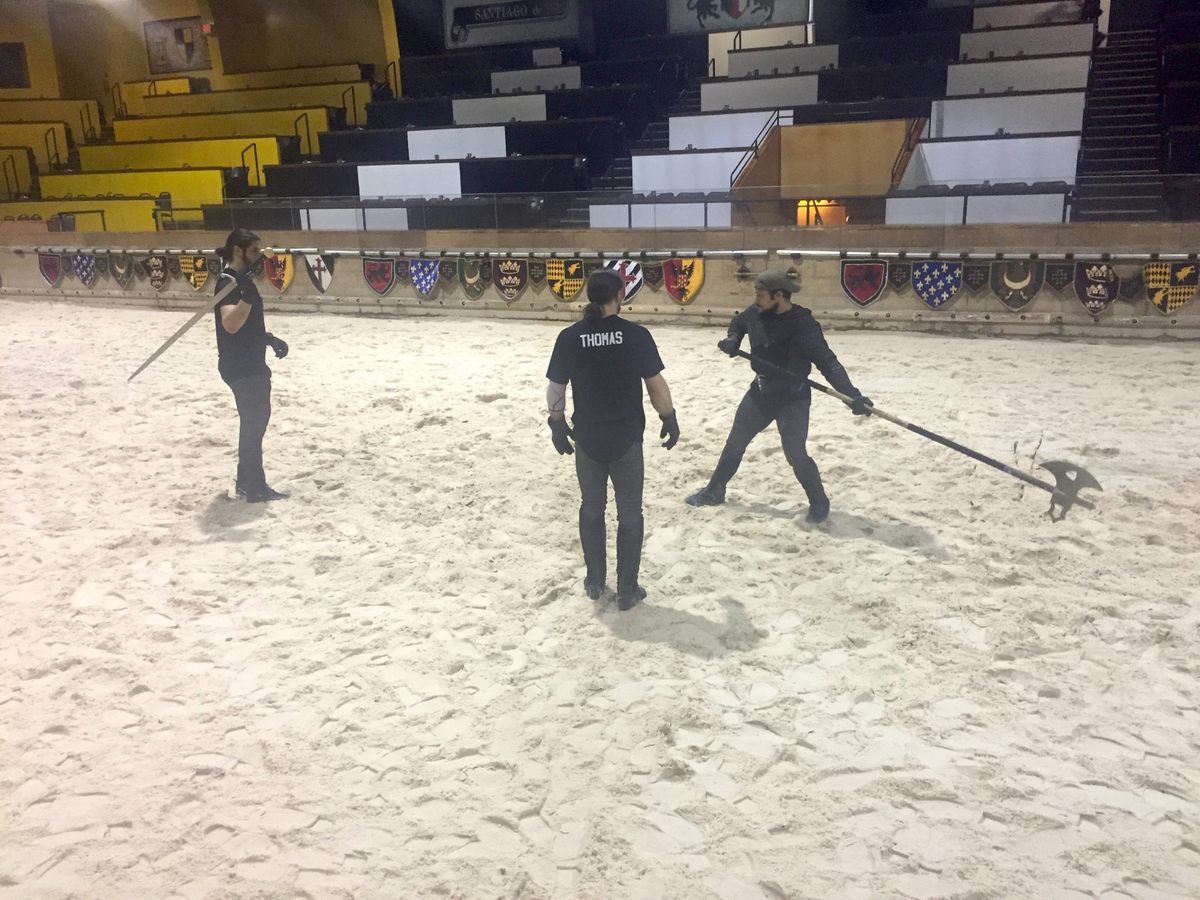
Ella: The head knight, Adam Panissidi, gave us the lowdown on the knight-training and qualification process. While there is no minimum height—or minimum hair length—the knights tend to be tall, with lustrous flowing locks.
Urvija: We learned that the requirements to become a knight are strict. Adam, who has been with Medieval Times for nine years, trained for three and a half months to get into the show, although for some knights the training process can last for up to a year. “The more athletic you are, the easier it seems to come,” Adam said.
Ella: The standard “corporate career path” for a knight is to begin as a stablehand or squire. Squires are essentially the stagehands for the show—they pick up broken jousting poles, set up rows of flags, and walk in front of the mounted knights whenever they parade around the arena.

Urvija: Once the squires become comfortable in the arena and around the weapons and horses, they take a “Head-Leg-Shoulder” test, which determines whether the squire is physically fit enough to start training to be a knight.
Each year, a corporate head knight travels to every Medieval Times castle in the country, and the knights in each one are required to pass a fitness test to show that they are keeping in shape. Adam told us that the test consists of a mile run in under 10 minutes, 30 pushups, 50 situps, and a minimum of five pull ups. This is the moment Ella and I realized that neither of us could be knights.
Ella: Also, there are no lady knights. There should be lady knights. That may be anachronistic, but so are the flashing laser swords sold in the gift shop.
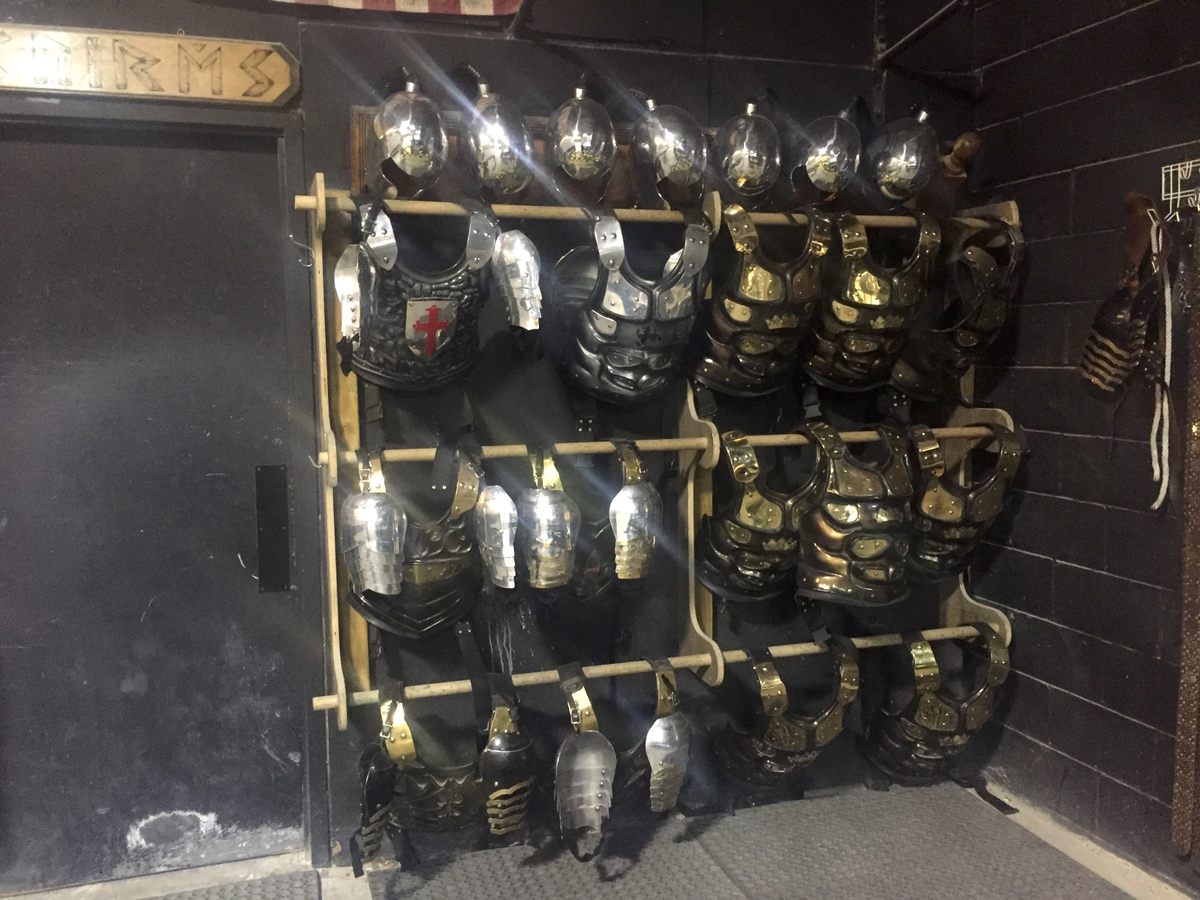
Urvija: Adam explained that the knights do their best not to get injured in carrying out their fierce battles and jousts, but that it happens from time to time. “The concept is that the fights are choreographed so specifically so that you don’t [get injured],” he said. “But sometimes, Mother Nature takes over: a sword breaks, I’ve gotten stitches in the forehead, I’ve slammed my finger with a big bola because I wasn’t holding it correctly. Sometimes it’s inevitable, but it’s usually few and far between.”
Ella: Once we had watched the knights fight each other for a while, we went to meet the king. In Medieval Times lore, he’s known as Don Carlos, but he introduced himself to us as Joshua Callahan. Josh has been at Medieval Times for five years.

Ella: As well as playing the king, Josh manages staff in the show’s other speaking roles: princess and lord chancellor. He said that if you want to be a Medieval Times king, princess, or Lord Chancellor—the three speaking roles in the cast—you need to submit a job application, then perform a prepared monologue on camera so the higher-ups at corporate can see if you fit with the vibe of the castle.
Urvija: Josh explained that most of the people in the show cast had prior acting experience, or if not, they had backgrounds in speaking or performing in some way. If Medieval Times has a full house, being part of the show cast is like performing for a theater full of almost 1,500 people—roughly, the seating capacity at most Broadway shows.
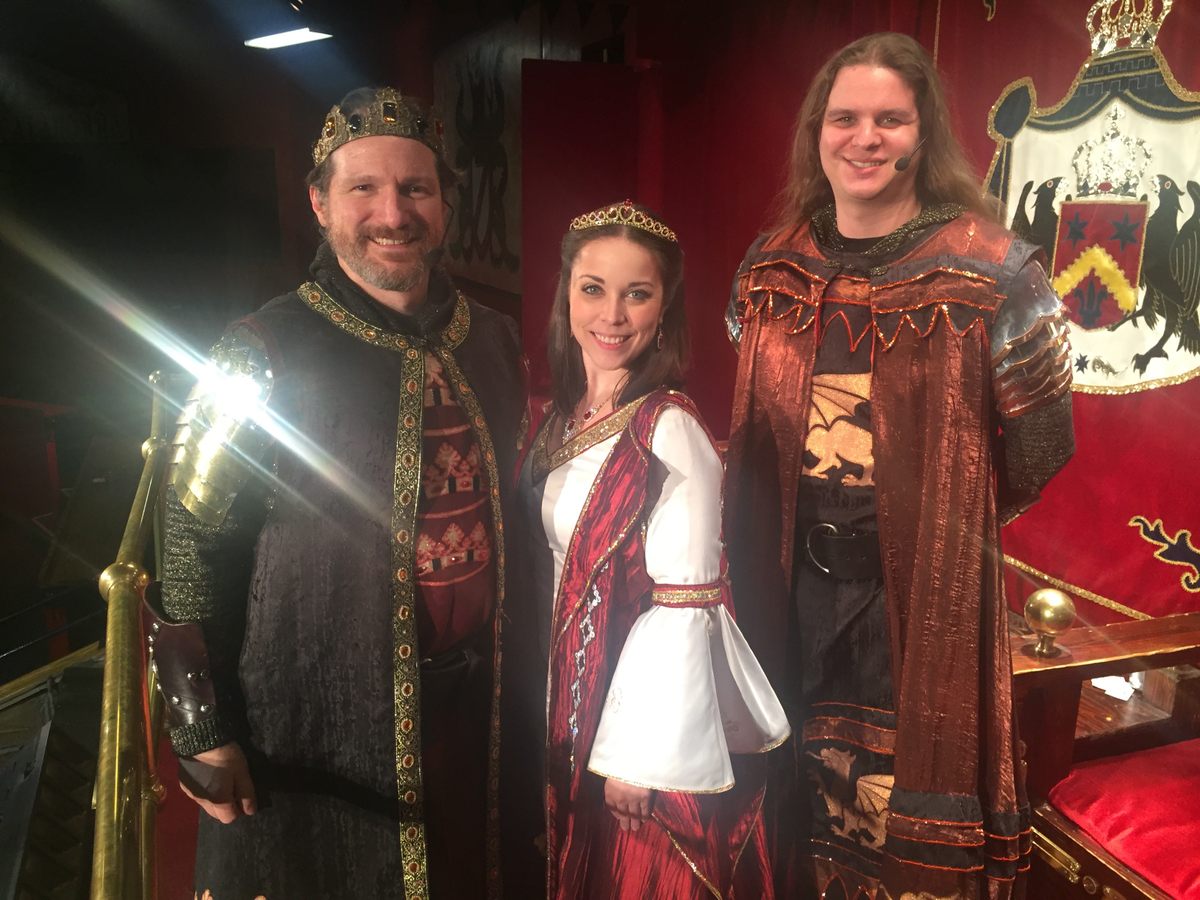
Urvija: There is one big difference between this and stage acting, however, which is the huge amount of improvisation on the part of the show cast. Before the show begins each night, the three characters are outside in the entrance hall of the castle, greeting and interacting with guests.
Beyond that, the show itself is live, with guests often seated right next to the stage. Guests can misbehave, too. Josh told us about a woman in the green booth who “thought it would be really cool to walk on stage to try and play the princess”. He had to get her offstage without breaking character.
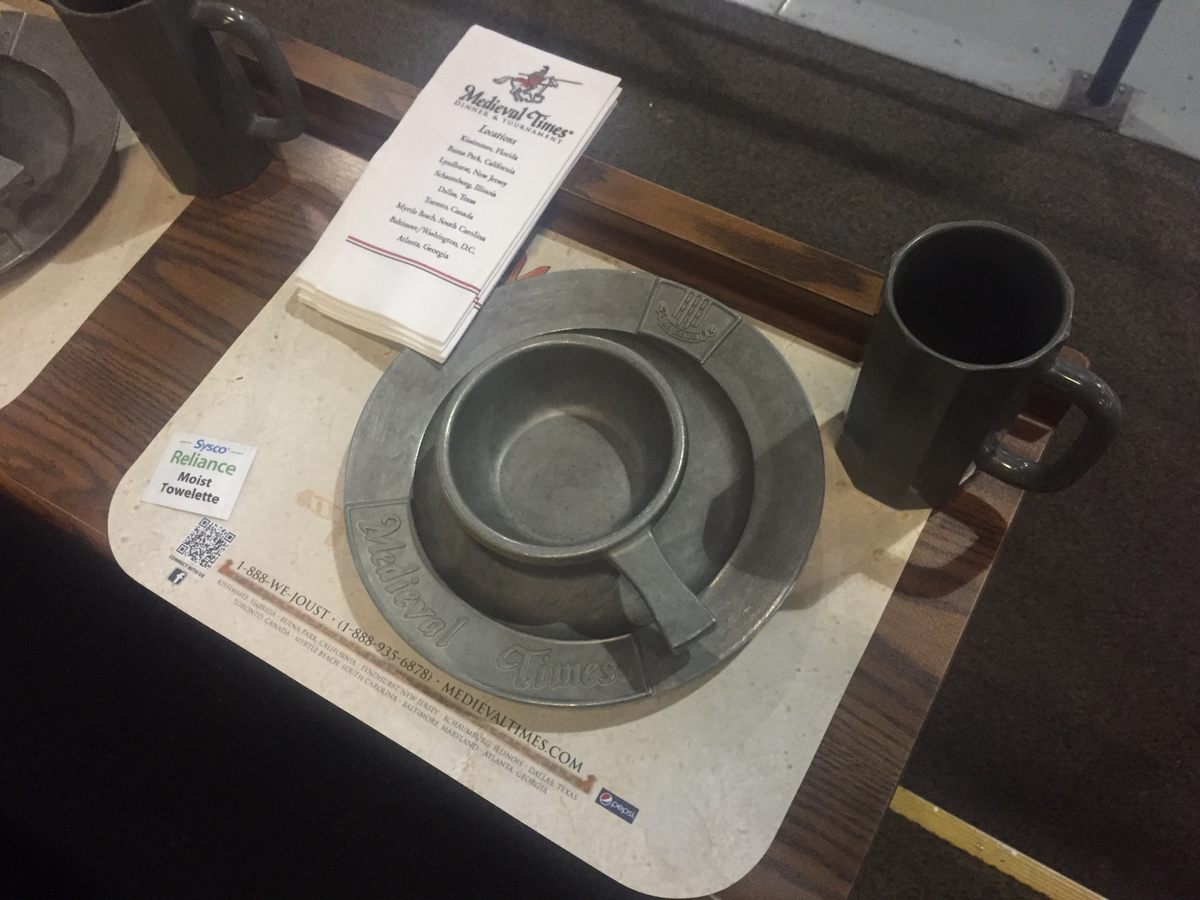
The Dinner and Tournament
Urvija: So the one thing I could not contain my excitement for was the food—the glorious four-course meal that you are obligated to eat with your hands. Never mind that I had read several Yelp reviews (because why would you even go to a restaurant without reading the Yelp reviews) that told me that the food was only “pretty good” or “average.” I didn’t care. I wanted to pick at a chicken with my fingers. I wanted to slurp soup from a bowl. When the food was presented in front of me, my expectations were pleasantly surpassed. The chicken was juicy and tender, the soup was tasty, and garlic bread is, well, garlic bread. You can’t go wrong there.
Ella: They really nailed the dramatic arena lighting and immersive sound effects at this 11th-century tournament. The show began with a voiceover spoken in a British(ish) female voice, accompanied by choral voices and a harp: “In myth and legend, the knight and the horse are forever linked…” The lights dimmed and that same Andalusian horse we met earlier—or maybe another one, they all look very similar—came bounding out onto the sand. There was an audible “Ooooh.”

Ella: Before the main action got underway, the king and princess read a list of announcements—shout-outs to people in the crowd, essentially. You could buy one of these announcements for $10 in the lobby before the show. A five-year-old got a birthday shout-out from his family. A woman celebrating her 36th birthday got one, too. As did a guy who was having his retirement party at Medieval Times that night. The wide range of announcements reflected the demographically diverse crowd. We saw families with kids; couples; groups of adults. And, yes. Some frat bros.
Urvija: The show commenced, and literal sparks began to fly as the knights began fighting one another with their weapons. The sparks, we had learned earlier, are a result of the ridges on the edges of the titanium swords that spark when they make contact at the right angle. The squires file the swords down before the start of each show to make sure that the sparks don’t fly into the knights’ faces, but create a kind of controlled mini-firework display instead.
Ella: Look, the jousting and fighting and horse prancing and all that stuff was wonderful, but here is what impressed me the most: our server, Sean, had this incredible timing-based technique for pouring the perfect amount of Pepsi to refill your tankard in the dark. When we talked to him later, we discovered he has been working at Medieval Times for 16 years.

Urvija: Not sure how that can be more impressive to you than the actual sword fighting that was going on in front of our noses. We had seen earlier that the knights choreograph each blow administered to one another in order to prevent injury, for example by pivoting their swords at exactly the right moment when hitting an opponent. The entire combat performance feels like a dance, in that way, in which you and your partner are doing your level best not just to get the moves down, but also to not seriously maim or injure one another.
Ella: The crowd got pretty riled up and vocal, but not in an obnoxious way. Except for the guy behind us who kept yelling, “Yeah! RIDE that HORSE!” Could have done without that.
The Coronation
Ella: At the end of the final joust, the winning knight goes into the crowd and chooses a Queen of Love and Beauty. On this special evening, the blue knight, accompanied by the princess, stepped from the tournament arena, walked past many deserving young girls, and stopped when he reached me.
Urvija: As the knight walked over to our section, I was entirely expecting him to stop at a seven-year-old girl waving the $30 flag her parents bought her.
Ella: As was I. But no. Sorry ‘bout your dreams, kid. Tonight, this tiara and sash were meant for me.
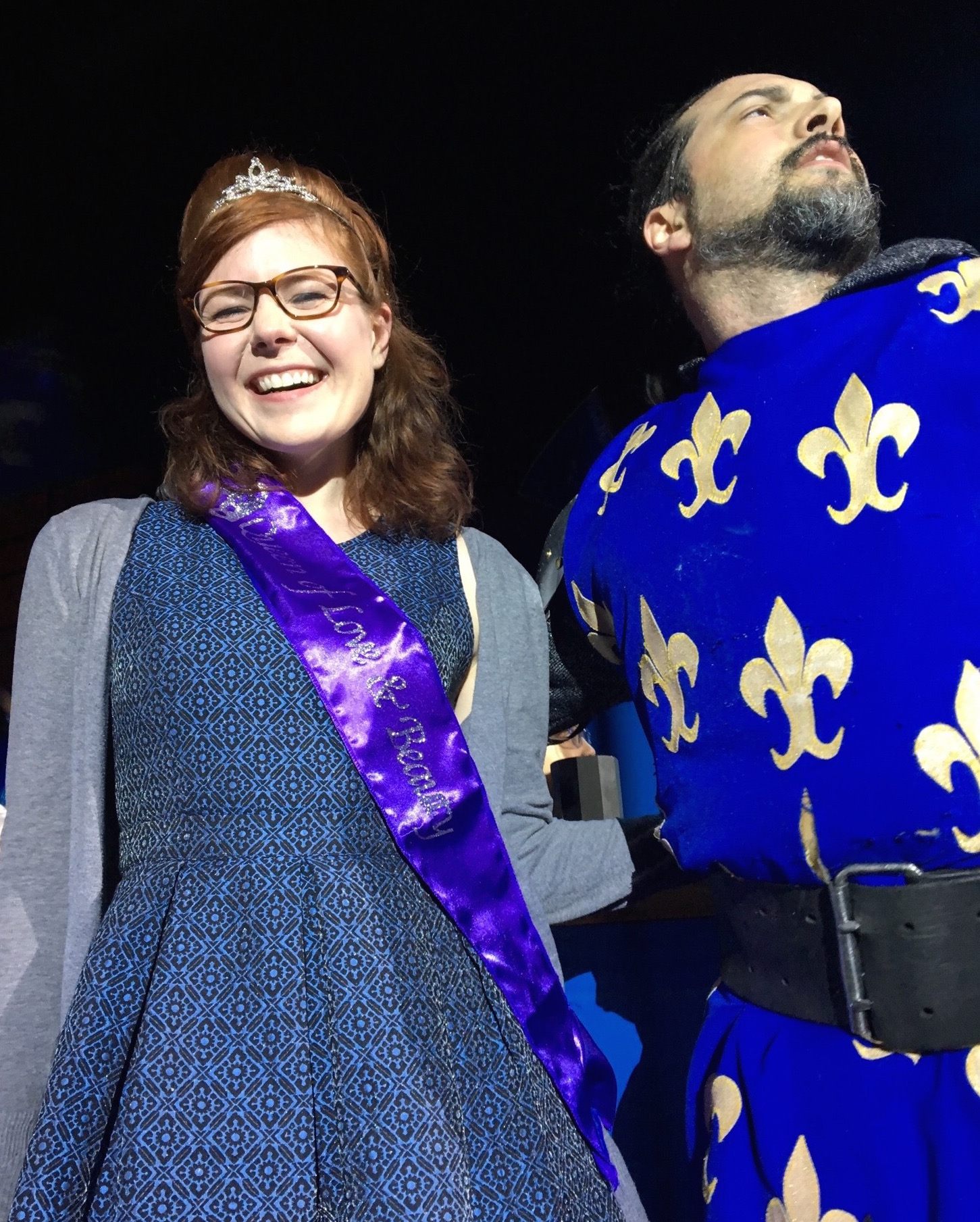
Ella: There is something incredibly validating about being crowned queen by a victorious knight who chooses you personally from a pool of, in theory, 500 candidates. You start to think, “What is it about me that exudes such elegance; such royalty?” In this case, the answer was probably “the knight got told by the marketing guy that the lady in the fifth seat was here reporting a story.” But still. It makes you think.




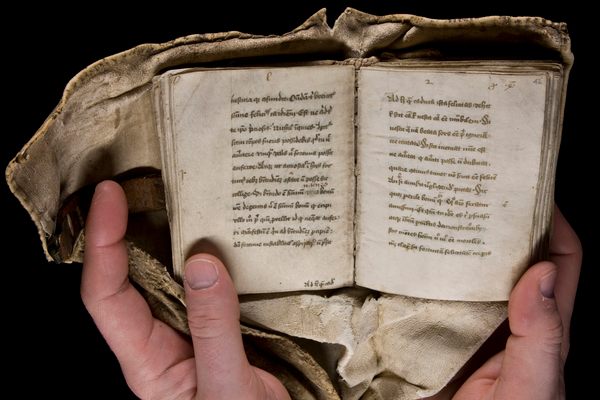
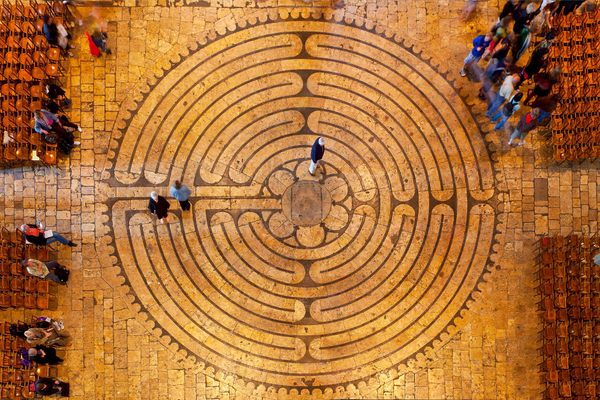









Follow us on Twitter to get the latest on the world's hidden wonders.
Like us on Facebook to get the latest on the world's hidden wonders.
Follow us on Twitter Like us on Facebook